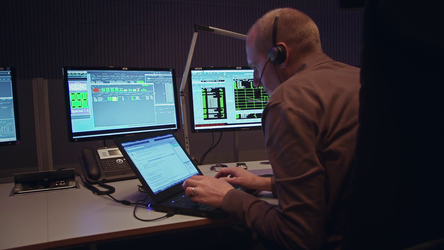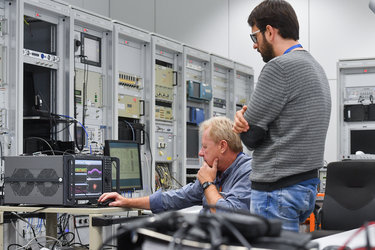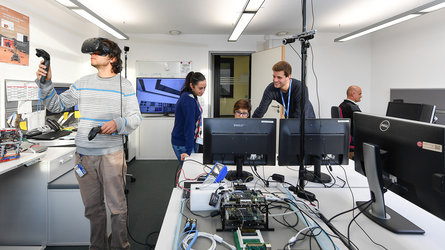Accept all cookies Accept only essential cookies See our Cookie Notice

About ESA
The European Space Agency (ESA) is Europe’s gateway to space. Its mission is to shape the development of Europe’s space capability and ensure that investment in space continues to deliver benefits to the citizens of Europe and the world.
Highlights
ESA - United space in Europe
This is ESA ESA facts Member States & Cooperating States Funding Director General Top management For Member State Delegations European vision European Space Policy ESA & EU Space Councils Responsibility & Sustainability Annual Report Calendar of meetings Corporate newsEstablishments & sites
ESA Headquarters ESA ESTEC ESA ESOC ESA ESRIN ESA EAC ESA ESAC Europe's Spaceport ESA ESEC ESA ECSAT Brussels Office Washington OfficeWorking with ESA
Business with ESA ESA Commercialisation Gateway Law at ESA Careers Cyber resilience at ESA IT at ESA Newsroom Partnerships Merchandising Licence Education Open Space Innovation Platform Integrity and Reporting Administrative Tribunal Health and SafetyMore about ESA
History ESA Historical Archives Exhibitions Publications Art & Culture ESA Merchandise Kids Diversity ESA Brand Centre ESA ChampionsLatest
Space in Member States
Find out more about space activities in our 23 Member States, and understand how ESA works together with their national agencies, institutions and organisations.
Science & Exploration
Exploring our Solar System and unlocking the secrets of the Universe
Go to topicAstronauts
Missions
Juice Euclid Webb Solar Orbiter BepiColombo Gaia ExoMars Cheops Exoplanet missions More missionsActivities
International Space Station Orion service module Gateway Concordia Caves & Pangaea BenefitsLatest
Space Safety
Protecting life and infrastructure on Earth and in orbit
Go to topicAsteroids
Asteroids and Planetary Defence Asteroid danger explained Flyeye telescope: asteroid detection Hera mission: asteroid deflection Near-Earth Object Coordination CentreSpace junk
About space debris Space debris by the numbers Space Environment Report In space refuelling, refurbishing and removingSafety from space
Clean Space ecodesign Zero Debris Technologies Space for Earth Supporting Sustainable DevelopmentLatest
Applications
Using space to benefit citizens and meet future challenges on Earth
Go to topicObserving the Earth
Observing the Earth Future EO Copernicus Meteorology Space for our climate Satellite missionsCommercialisation
ESA Commercialisation Gateway Open Space Innovation Platform Business Incubation ESA Space SolutionsLatest
Enabling & Support
Making space accessible and developing the technologies for the future
Go to topicBuilding missions
Space Engineering and Technology Test centre Laboratories Concurrent Design Facility Preparing for the future Shaping the Future Discovery and Preparation Advanced Concepts TeamSpace transportation
Space Transportation Ariane Vega Space Rider Future space transportation Boost! Europe's Spaceport Launches from Europe's Spaceport from 2012Latest

Testing software
Thank you for liking
You have already liked this page, you can only like it once!
With increasing autonomy and onboard intelligence, the software used to control a mission – either on the satellite in space or in the mission control systems used on ground – has become enormously complex.
Today, a spacecraft like ESA’s Gaia has 42 000 telemetry parameters and 2650 control parameters (comparable to a mid-size jet aircraft) and hundreds of thousands of lines of code onboard. The ground systems that support the spacecraft additionally contain millions of lines of code, spread across the mission control systems, the flight dynamics systems and the ground stations.
It's no wonder that software validation – ensuring that all software components (often supplied by different vendors) work together as they should in a robust ’system of systems’ – is a major challenge.
Further, software is often customised to meet the unique requirements of individual spacecraft performing widely different scientific missions, so each new mission’s ground segment must be validated anew.
“Today, similar missions are grouped into families to exploit some commonalities and achieve some reuse and simplification in the needed software, but we must still conduct extensive validation,” says ESA’s Jean-Christophe Berton, responsible for test facilities and management support at ESOC.
“Manual testing is possible; however, it is a long process and is prone to errors. So the best way forward is to employ automation to conduct testing.”
The GSRF has developed a set of automated tests to speed up and standardise the process. These can run unattended for long periods, over nights and weekends.
This saves time and, more importantly, it enables human experts to focus on the problems and processes that automation can’t handle.
“In the end, though, some aspects of testing can only be done by engineers,” says Jean-Christophe.
-
CREDIT
ESA/J. Mai -
LICENCE
ESA Standard Licence

OPS-SAT

Tiny sat, big ambitions

Mission control system

Prevention is better than cure















 Germany
Germany
 Austria
Austria
 Belgium
Belgium
 Denmark
Denmark
 Spain
Spain
 Estonia
Estonia
 Finland
Finland
 France
France
 Greece
Greece
 Hungary
Hungary
 Ireland
Ireland
 Italy
Italy
 Luxembourg
Luxembourg
 Norway
Norway
 The Netherlands
The Netherlands
 Poland
Poland
 Portugal
Portugal
 Czechia
Czechia
 Romania
Romania
 United Kingdom
United Kingdom
 Slovenia
Slovenia
 Sweden
Sweden
 Switzerland
Switzerland

























